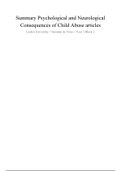Summary Psychological and Neurological
Consequences of Child Abuse articles
Leiden University // Suzanne de Vries // Year 3 Block 2
,L1: Childhood adversities and adult psychiatric
disorders in the national comorbidity survey replication
I Green, McLaughlin, Berglund, Gruber, Sampson, Zaslavsky & Kessler
Retrospectively reported CAs are often highly clustered and we require examination of multiple CAs
to avoid overestimating associations involving them. They are often nonspecific in their associations
with different mental disorders. This study analyses the CAs assessed in the replication of the
National Comorbidity Survey (NCS-R). Examine associations of CAs with first onset of DSM-IV
disorders based on multivariate models.
Methods
Sample
NCS-R: English-speaking adults, sample of US household population. Part 1: core diagnostic
assessment, part 2: questions about correlates and additional disorders to people who met criteria for
any part 1 disorder + probability subsample of others. Part 2 sample is used in this study.
Diagnostic assessment
World Health Organization Composite International Diagnostic Interview (CIDI) + DSM-IV. Assess
mood disorders, anxiety disorders, disruptive behavior disorders and substance use disorders.
Childhood adversities
Questions about three types of personal loss, four types of parental maladjustment, three types of
maltreatment and two others. Responses were coded dichotomously.
Analysis methods
Intercorrelations among CAs, associations of CAs with lifetime disorders.
Results
Prevalence and co-occurrence of CAs
Most CAs have significant loadings on the first factor of maladaptive family functioning (MFF).
Associations of CAs with the first onset of DSM-IV/CIDI disorders
All but one (parental death) were significant. Reject hypothesis that the odds ratios (OR) are the same
for all CAs. There are generally increasing ORs with the number of CAs. The hypothesis that the ORs
are the same for all types of CAs can also be rejected. The MFF type CAs consistently have higher
ORs than other CAs. Although the odds of disorder onset increase with increasing number of CAs,
they increase at significantly decreasing rate.
,Differential associations by class of DSM-IV/CIDI disorder
Each MFF CA is significantly associated with each disorder class with rather consistent ORs.
Differential associations by life course stage and number of previous disorders
Significant ORs of some, but not all, CAs persist throughout the life course. ORs associated with most
CAs become smaller as the number of previous disorders becomes larger.
Population-level associations of CAs with disorder onset
CAs explain around 32% of all disorders, 41% of disruptive behavior disorders, 32% of anxiety
disorders, 26% of mood disorders and 21% of substance use disorders. They explain a higher
proportion of childhood-onset than adolescent/adult-onset disorders.
Effects of time to recall
Any bias in prevalence estimates is likely conservative in the total sample because of lower reporting
in elderly. Generally good consistency between ORs estimated in younger cohorts vs. entire sample.
Comment
Study is limited by retrospective nature of the data. List of CAs might not have been exhaustive. Did
not consider timing, sequencing, persistence, recurrence or severity of CAs.
Multivariate structure of associations between CAs and disorder onset was found to be nonadditive,
mostly confined to the MFF CAs. Little specificity in the associations between CAs and disorders.
Implication is that causal pathways that link CA to disorder onset are general. Confounders could be
genes, respondent behaviors and predispositions. Associations of many, but not all, CAs with first
onset of DSM-IV disorders persist into adulthood.
L1: What mediates the link between childhood
maltreatment and depression? The role of emotion
dysregulation, attachment and attributional style
Schierholz, Kruger, Barenbrugge & Ehring
CM and risk for depression
Particularly strong association between CM and MDD. Not only increased risk for development but
also predicts severity and course.
, Mediators of the link between CM and depression
Depression following CM supposedly characterized by neuroendocrine and neuroanatomical changes
in central stress response systems. This study investigates three mediators.
Emotion regulation difficulties
Evidence: found to mediate, CM leads to ER difficulties, ER difficulties shown to be associated with
depression.
Attachment
Evidence: association between CM and insecure attachment, also in adulthood. Also between insecure
attachment and risk for depression.
Attributional style
Evidence: predicts depressive reactions and more chronic course, not shown mediating relationship.
This study
Hypotheses: CM associated with more severe depression and higher number of episodes, CM and
severity+course of depression associated with proposed mediators, and proposed mediators reveal
substantial indirect effect in explaining relationship between CM and depression severity and number
of depressive episodes.
Methods
Participants
Web-based survey, should have expected lifetime diagnosis of MDD according to PHQ-9, 340
participants.
Materials
Depression
Depression module of PHQ-9.
Childhood maltreatment
Short version of the CTQ.
Proposed mediators
ER difficulties: DERS, attachment: ECR, depression: DAQ, PTSD: PDS.





